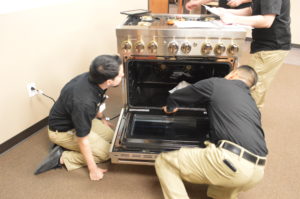Dishwashers are supposed to clean your dishes, right? That’s what they’re designed for, but unfortunately, a lot of it relies on us to make sure your dishes are effectively getting cleaned. Did you know that about 43% of our calls for servicing dishwashers aren’t because of a mechanical failure? If you’re struggling with food soil being left on your dishes after a load, you’re in for an eye opener in our troubleshooting tips and tricks listed out below:
- Is your dishwasher loaded correctly? We all have our own special way of loading dishes and some of us even go behind to arrange them to our preference, but did you know that there is actually a “correct” way to organize your dishes? We covered this in a previous blog, learn how to properly Load Your Dishwasher!
- What cycle did you use? Most of us just want our dishes done. We don’t spend too much time really getting to know our dishwasher. If you notice that some of your dishes have heavier soil, time to bust out the heavy cycle.
- How much detergent did you use? Your mom or grandma might have taught you to wash your dishes, well… before you wash your dishes… but did you know that enzymes found in dish soaps require some food soil to even be activated?! Now that’s contrary to historical beliefs! Today’s quality soaps use enzymes or bleaches to clean dishes. Enzymes will help clean your proteins and starch based stains, where bleach-based are more oxidizing and take care of coffee and tea stains. Powders rank higher, but for the best, we recommend to use a quality type soap like Finish Quantum tablets, because it contains both the enzyme and bleach separated in the tab. Make sure for better cleaning and drying, you are using a rinse aid and it is full (located in your dispenser).
- Was there leftover detergent in the dispenser? If so, you either had a long pan or plate blocking the dispenser door. If that’s not the case, we recommend visiting number 3 again. Use fresh detergent. Sidenote – Do not allow your detergent to sit in the dispenser for too long before running your load of dishes.
- How’s your water temperature? If your water is not getting up to 120 degrees, it’s not warm enough. Enzymes start to work best at about 100 degrees Fahrenheit, but then will die at 122 degrees Fahrenheit and are no longer effective. Bleach soaps start to work at 120 degrees Fahrenheit and lose their abilities about 155 degrees Fahrenheit. For best results – know your options! High temp washes may be your dish’s hero!
- Anything blocking the spray arm? If you’re a jar collector like some of us are (guilty), you may notice pieces of label that you weren’t quite able to get off leftover in the dishwasher. Make sure that those itty bitty pieces are not clogging your spray arm.
These are just some of the common tips and tricks for troubleshooting your dishwasher when food refuses to part ways with your dishes. We always recommend that you refer to your dishwasher’s Use and Care Guide provided by your manufacturer for special instructions pertaining to your particular make/model. If you’ve tried all of the above and it’s still not working correctly, put your trust in a professionally trained Guinco Service technician who sees this regularly. Thank you, for letting our family help yours!




